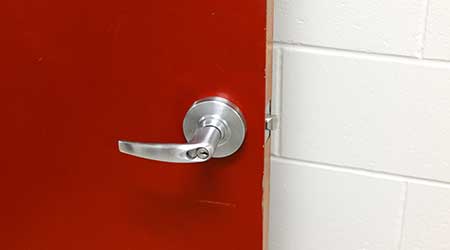
Changes to School Door Lock Code Address Dangerous Solutions
October 8, 2019
As schools have sought ways to protect their students and staff from an active shooter, many have turned to measures which ultimately can cause more harm than good. To help resolve the hurdles to effective and safe door hardening strategies, the National Fire Protection Association has released an emergency amendment addressing the types of locks allowed on school classroom doors.
Previously, schools were required by the 2018 edition of NFPA 101, Life Safety Code, to use lock/latch sets utilizing a single releasing operation when retrofitting classroom doors. Some schools decided this requirement was cost-prohibitive, according to NFPA, and resorted to stop-gap measures such as barricades, door wedges, rope, and other items. “It was determined by the Committees that a second, more cost-effective door lock/latch combination utilizing a second releasing operation would continue to deliver a high level of safety to students and staff while minimizing the need for well-intentioned but dangerously misguided applications,” says Gregory Harrington, principal engineer at NFPA, according to an NFPA release.
The Tentative Interim Amendment (TIA) in NFPA 101 allows that existing school doors can be retrofitted with secondary hardware, to be used in lieu of single operation hardware which combines a latch and lock together. The secondary hardware solution is only applicable to retrofit existing classroom doors.
- Regardless of the approach taken, the same rules apply to the secondary hardware solution:
- Engaging and disengaging the lock cannot require special knowledge, strength, or any other unique abilities.
- The door must be lockable without having to open it.
- Engaging the lock cannot require special knowledge, a key, or tool to engage or disengage from the classroom side of the door.
- The two releasing operations must not be required to be performed simultaneously to unlock/unlatch the door.
- The lock must be installed at an acceptable height between 34 to 48 inches above the floor.
- The door must have the ability to be unlocked and opened from outside the classroom with the necessary key or credential.
- The staff must be drilled in the engagement and release of the locks.
An updated FAQ page on school door safety can be found here.
Naomi Millán is senior editor of Building Operating Management.
Next
Read next on FacilitiesNet












